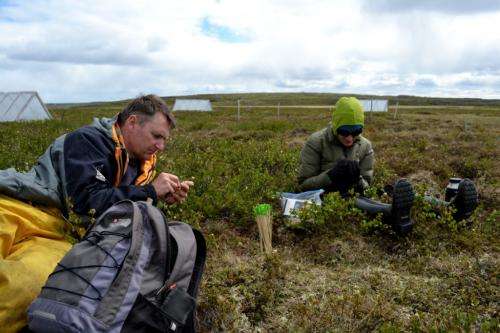Evergreens restrict Arctic tundra responses to climate change

How climate change will affect the Arctic is a research question of increasing urgency. New research out of Queen's University indicates that current predictions of vegetation change that will occur as the Arctic warms could only be part of the story. There are other key players that have been overlooked.
Using experimental greenhouses located at the Daring Lake Research Station in the Northwest Territories, Tara Zamin (former PhD student, Biology), co-author Paul Grogan (Biology) and co-author Donie Bret-Harte (University of Alaska Fairbanks) demonstrated that climate change impacted the vegetation much differently than has been observed at other Arctic sites, leading to more conservative predictions for tundra change. They are the first scientists to carefully measure not only above but also belowground growth responses of individual plants, thereby allowing them to comprehensively assess how each Arctic species is being affected.
"It's the turtle and the hare of the Arctic tundra in the ongoing race to adapt to a changing climate. Deciduous shrubs are the hare, and have been rapidly increasing in more fertile arctic sites, leading to predictions that the tundra could become a birch or willow shrubland, which would feed back to increased warming. Evergreen shrubs are the turtle - slow, but well adapted to the infertile soils typical of Arctic tundra, and at our site are presently in the lead."
"Our results are important because evergreens grow more slowly, are shorter, and produce litter that tends to restrict soil nutrient availability, all of which will tend to slow down the responsiveness of tundra ecosystems to climate change," says Dr. Grogan.
As temperatures continue to rise in the Arctic, the warming will enhance soil nutrient availability. The study concludes that although deciduous shrubs are likely to become dominant in particularly fertile locations in the tundra, evergreens will dominate elsewhere.
"Over this century, we can expect substantial vegetation change across southern Canada and at lower latitudes more generally," says Dr. Grogan. "As ecologists, our goal is to understand and predict what those changes might be. Will evergreen trees like cedar fare better than deciduous species like maple? The latter is an important species culturally and economically for Canada, and therefore the answers to such questions are critical to successfully adapting to the climate change that we have already committed ourselves to."
More information: "Evergreen shrubs dominate responses to experimental summer warming and fertilization in Canadian mesic low arctic tundra." Tara J. Zamin, M. Syndonia Bret-Harte and Paul Grogan. Journal of Ecology. Article first published online: 21 MAR 2014. DOI: 10.1111/1365-2745.12237
Journal information: Journal of Ecology
Provided by Queen's University




















